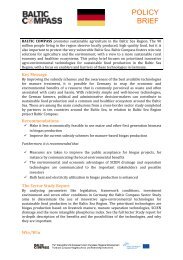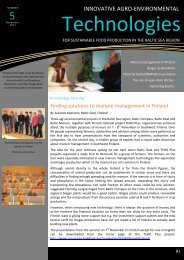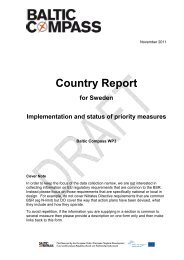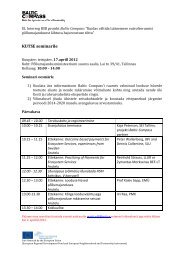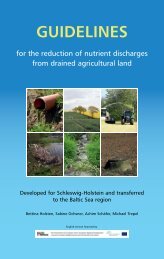A_Greener_2011_Sånga-Säby - Baltic Deal
A_Greener_2011_Sånga-Säby - Baltic Deal
A_Greener_2011_Sånga-Säby - Baltic Deal
You also want an ePaper? Increase the reach of your titles
YUMPU automatically turns print PDFs into web optimized ePapers that Google loves.
Conference report: A <strong>Greener</strong> Agriculture for a Bluer <strong>Baltic</strong> Sea, <strong>2011</strong>10Two elements are crucial for these results: efficient fertilizer products and precisionfarming – many tools for decisions support has been developed to help the farmer decide whenand how much fertilizer is needed, e.g. the Yara N-Sensor® detects areas of different Nsupply and adjusts N fertilizer rates accordingly.It was concluded that best fertilizer management is supported by tools and precisionfarming applications that combine innovative technology with agronomic knowledge.Professor Jan Bengtsson, from Dept of Ecology and the Future Agriculture ResearchInitiative, SLU – Swedish University of Agricultural Sciences, gave a view of the futureagriculture in his presentation entitled Multifunctional Agriculture? - <strong>Baltic</strong> agriculture andecosystem services in an unforeseeable future.Food is a basic Human right and not substitutable. But how will future agriculture be inthe <strong>Baltic</strong> Sea Region? Extrapolations from the past are always problematic, and today’s goalsmay be irrelevant in 2050. You can show alternative plausible scenarios to be discussed – howto achieve or to avoids parts of these scenarios.Climate change (water, temperatures) and resource scarcity (population growth, nutrients,land, energy etc) are fundamental problems, we ‘consume the capital rather than the interest’today. Numerous scenarios were presented and discussed:- An overexploited world- A world in Balance- Changes in balance of power- The world awakens- A fragmented worldResearch challenges were discussed and it was concluded, that multifunctional agriculturalsystems may prove most robust to the future challenges delivering goods (food, fodder,biomass, timber) and ecosystem services (pollination, sol fertility, carbon sequestration,nutrient retention) and cultural services (biodiversity, recreation, health, rural livelihood etc).After three parallel seminars (described below) the coming reform of the Common AgriculturalPolicy of the EU was presented and discussed by Rikke Lundsgaard, Danish Society forNature Conservation and Carl Wachtmeister, Federation of Swedish Farmers.The Commission proposal of October <strong>2011</strong> has in Pillar 1 a basic support with a flat rateper hectare (single payment) with a maximum support per farmer. In addition, the farmer canachieve ‘Greening support’ via crop diversification, ecological focus, permanent grass lands etcand some Special Premiums for small farmers, young farmers etc as top-up support. The Ruraldevelopment Programme (Pillar 2 of the CAP) supports organic production, competitiveness,innovation, environmental measures, climate change, animal welfare etc.This proposal is to be discussed and adapted, so things may change.The two representatives gave their views on the proposal with a fruitful and constructivedialogue, involving a very active audience. No clear conclusions can be drawn, but the overallpurpose of the conference with dialogue between key stakeholders was definitely fulfilled..The conference was co-financed by the European Union (European Regional Development Fund and European Neighbouringand Partnerships Instrument) and organised by the project cluster <strong>Baltic</strong> Compass, <strong>Baltic</strong> <strong>Deal</strong> and <strong>Baltic</strong> Manure



